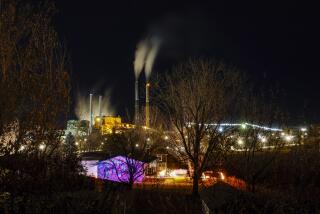Wyoming Mines Producing More Coal, but Not Hauling in Tons of Cash
- Share via
GILLETTE, Wyo. — In about two months’ time, Bill Sims and the three other members of D crew at Jacobs Ranch coal mine will have moved enough earth to rival Devils Tower.
In a squarish hole terraced with roads leading more than 100 feet into the Earth, Sims and his team carefully manipulate two-story trucks used to remove dirt and rocks, called “overburden,” covering a 50-foot coal seam.
Once the seam is exposed, powerful explosives shatter the coal into a ready-to-use size that Sims’ crew hauls to silos for storage until it can be loaded into mile-long freight trains bound for the Midwest and Texas.
Theirs is a sort of heavy-machinery ballet played out 50 to 75 times a day on a 2,400-foot stage known as Pit 1, surrounded by the rolling hills of the high plains dotted with sagebrush and native grasses.
The routine continues around the clock all but three days a year. It has helped make the Kerr-McGee Powder River Basin mine the fourth-largest in the country.
Production throughout the Powder River Basin, which provides 90% of Wyoming’s coal, has increased steadily since mining started in earnest in the early 1970s. Wyoming is now the nation’s leading coal-producing state, boasting a $1.2-billion industry.
And there’s no end in sight. Experts say Wyoming could supply one-quarter of the nation’s coal for another 200 to 300 years.
Back in the 1970s, Wyoming’s coal mines supplied about 200,000 tons of coal a week, far short of the 6 million tons that now leave the state each week aboard the steady stream of trains lumbering south and east.
The increase is due largely to greater demand for Wyoming’s low-sulfur coal among utilities seeking a cleaner-burning fuel. Also, a plunge in prices has forced producers to increase production to keep up earnings.
Industry officials say the strengthening of air pollution standards since 1990 has boosted demand for low-sulfur coal, which releases less sulfur dioxide than other coals when burned.
At the same time, lower prices have forced producers to trim to a bare-bones staff that must work three times harder to bring in enough coal to turn a profit.
In the 1970s, a ton of Wyoming coal sold for between $10 and $12. Prices topped out at $12.75 per ton in 1982, but during the last five years short-term contract prices have hovered around $3.50 a ton.
And prices, according to the director of the Wyoming Mining Assn., probably won’t increase for at least two or three years.
“I’ll be happy if they keep from dropping,” said Marion Loomis.
Wyoming has been unable to turn record production into record profits because it is caught in a buyers’ market, he said.
Coal sold on short-term spot contracts of less than a year grab a larger percentage of Wyoming coal sales every year. In 1985, low-priced tonnage accounted for 6% of sales. Eleven years later, that number grew to 75%, and it is expected to reach 96% by 2002, according the Geological Survey of Wyoming.
At its peak, the industry employed more than 6,000 in Wyoming, but now has about 4,400 workers.
“They’re not happy about laying people off, but they are more efficient, and that’s what’s keeping companies in business,” Loomis said.
Jacobs Ranch employs about 400, including Sims, who reluctantly admits he’d rather be ranching than spending 12-hour shifts making the drive from point A to point B and back again.
But after running his own sheep and cattle ranch near Cody for 16 years, Sims discovered the income wasn’t enough to support his wife and three children.
“Although it’s true that several of our employees have gone to college, I don’t know of too many $40,000-a-year jobs available to people with just a high school diploma,” said Dick Turpin, the mine’s engineering manager.
The industry generated about $513 million in taxes and royalties in 1996 and spends about $237 million in payroll annually.
Turpin said a typical household uses seven tons of coal each year. Jacobs Ranch produces enough coal to run 3.5 million of those houses.
“I think God meant for us to mine coal,” he said. “It’s not like we’re knocking down the rain forest. All we’re doing is setting aside the topsoil, removing coal and putting the topsoil and vegetation back. In many cases, we leave the land in better condition than we found it.”
Environmental groups don’t consider mining that benevolent. They worry about the industry’s impact on ground water, soil and air quality, and they warn that it could eventually threaten Wyoming’s No. 2 industry: Tourism.
Despite their concerns, officials with one environmental group, the Powder River Basin Resource Council, said Jacobs Ranch has kept its commitment to quickly restore land disturbed by mining.
Antelope, rabbits and birds are thriving in the windblown areas of Jacobs Ranch that have been mined, Turpin said.
Resource Council chairman Bob Strayer said his group has never opposed mining in the dry basin, hemmed to the northwest by the Big Horn Mountains and to the east by the Black Hills. Devils Tower soars 1,267 feet above the gently rolling plains sloping to the Black Hills.
“Our position is, we want it done in a responsible way to the environment and the communities of Wyoming,” Strayer said. His organization was founded by ranchers worried about water in the basin. Wyoming has 10 times as many cattle and sheep as people.
“Part of the problem is the federal [reclamation] requirements are not clearly defined,” Strayer said.
Only 25% of the 40,272 acres of land disturbed by mining has ever been reclaimed, he said.
“We don’t consider that ‘timely,’ ” he said. “We believe 180 days is reasonable turnaround time, but the mines have consistently fought any quantifiable timeline.”
Mines remove anywhere from 80 to 150 feet of topsoil and overburden that have generally been isolated from air and water.
“When they are [exposed], they can be, to some degree, toxic,” he said. “That’s one of the reasons reclamation is so important.”
Strayer said ranchers have told him their wells are drying up. They attribute that to the industry, which removes water surrounding coal seams.
“For the last 10 years, we’ve been trying to get a comprehensive, cumulative impact study on water resources, but it has yet to materialize,” he said.
The mines depend on a wide array of heavy machinery burning diesel fuel and stirring up dust, both of which hurt air quality.
“If you drive through the basin on Highway 59 in the early morning, you can see a brown haze that wasn’t there before mining began,” Strayer said. “The question we have to ask is, how important is it to the state to preserve the clean air and the pristine environment?”
More to Read
Sign up for Essential California
The most important California stories and recommendations in your inbox every morning.
You may occasionally receive promotional content from the Los Angeles Times.










